✨ Side blog. 🧬 Neurodivergent. 🚀 Agnostic. 🥄 📖 Advocate for global science literacy. Reading. Research. 📚
Don't wanna be here? Send us removal request.
Text
The earliest documented accounts of serious thought toward physics, especially the motion of the stars and planets, date back to ancient Chinese, Indian, Egyptian, Meso-American, and Babylonian societies.
— Charles Liu, The Handy Physics Answer Book
#Charles Liu#The Handy Physics Answer Book#atypicalreads#nonfiction#science#reading#physics#bookblr#quotes#science quotes#physics quotes#third edition#chinese#indian#egyptian#mesoamerica#meso-american#babylonian#physicist
1 note
·
View note
Text
Physics is the scientific study of the structure, content, and activity of and in the world and universe around us. Physics seeks to explain natural phenomena in terms of a comprehensive theoretical framework in mathematical form. Physics depends on accurate instrumentation, precise measurements, and the rigorous expression of results.
Physics is often called the "fundamental science" because it is the core of many other sciences, such as astronomy, biology, chemistry, and geology. Is it also the basis of many fields of applied sciences, such as aeronautics and astronautics, engineering, computer science, and information technology. A strong knowledge of physics is a powerful tool to have in today's high-tech world.
— Charles Liu, The Handy Physics Answer Book
#Charles Liu#The Handy Physics Answer Book#atypicalreads#nonfiction#science#reading#physics#bookblr#quotes#science quotes#physics quotes#third edition
2 notes
·
View notes
Text
Physics explains how and why things work the way they do. Far from being dense or difficult, physics can be described by a set of simple laws; and just as the 26 letters of the alphabet can be combined in a myriad of ways to tell amazing stories, the laws of physics that govern the world and the universe around us produce powerful, beautiful, and even mind-blowing phenomena.
Think of waves at the beach, music in your ears, the colors of the rainbow, or nuclear fusion in the Sun; all of these and so much more arise from physics.
— Charles Liu, The Handy Physics Answer Book.
#Charles Liu#The Handy Physics Answer Book.#atypicalreads#nonfiction#science#reading#bookblr#quotes#science quotes#physics#third edition#physics quotes
6 notes
·
View notes
Text
“The size and age of the Cosmos are beyond ordinary human understanding. Lost somewhere between immensity and eternity is our tiny planetary home. In a cosmic perspective, most human concerns seem insignificant, even petty. And yet our species is young and curious and brave and shows much promise. In the last few millennia we have made the most astonishing and unexpected discoveries about the Cosmos and our place within it, explorations that are exhilarating to consider. They remind us that humans have evolved to wonder, that understanding is a joy, that knowledge is prerequisite to survival. I believe our future depends on how well we know this Cosmos in which we float like a mote of dust in the morning sky.” ― Carl Sagan, Cosmos
40 notes
·
View notes
Text
You gave me flesh and blood And the will and the way To serve Thee, my Lord Until the judgement day It was written in stone You had a mission to save Why give me desire Just to prove I'm depraved?
— Laibach
#laibach#abuse and confession#jesus christ superstars#1996#1990s#90s#music#90s music#religion#Bohn#Chris Bohn#Ivan Novak#Milan Fras#S. Avsenik Jr.#Avsenik#Peter Penko#mute records#october 1996#industrial#political#words#quotes
2 notes
·
View notes
Text
Now the last traces fade away Of His creation gone wrong
Fish return to the river And whales sing their ocean song The bears roam in the mountains And buffaloes roam the plains Eagles fly in freedom Now nothing of man remains
In the kingdom of God The kingdom of God
Let silence be the music That settles on the Earth And thunder be the rhythm That drowns man's last words And let melody be the sound Of the wind and the lashing rain Blowing away man's harmonies Until nothing of him remains
In the kingdom of God The kingdom of God
So nothing of man remains In the kingdom of God The kingdom of God
— Laibach
3 notes
·
View notes
Text
You have played, (I think) And broke the toys you were fondest of, And are a little tired now; Tired of things that break, and — Just tired. So am I.
— "You Are Tired (I Think)" by E.E. Cummings
#e.e. cummings#you are tired#you are tired (i think)#poem#quotes#poetry#writers and poets#ee cummings
1 note
·
View note
Text
Round 3 - Mammalia - Primates

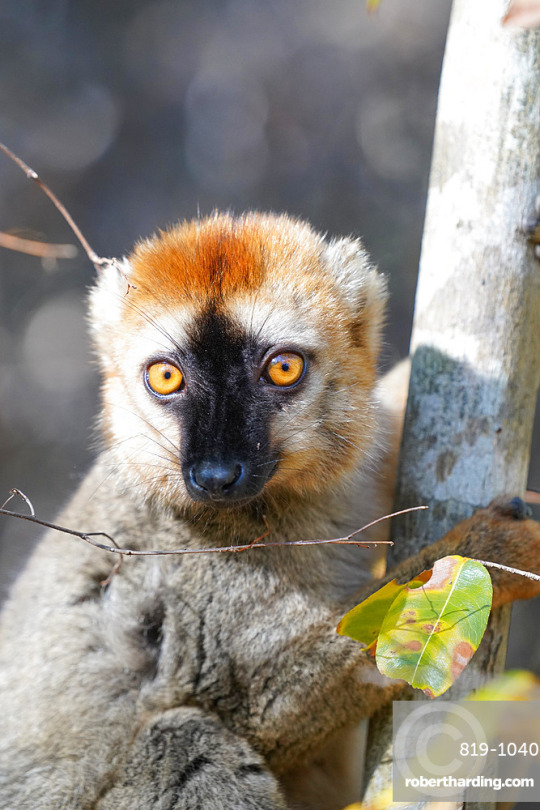

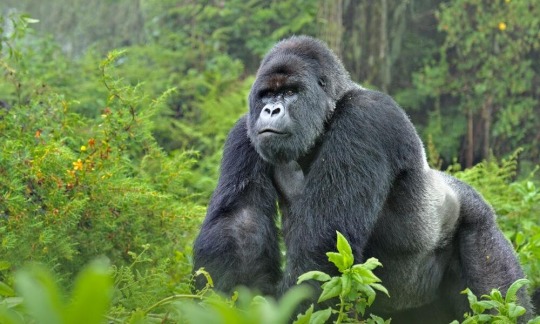
(Sources - 1, 2, 3, 4)
Our next and last group of Euarchonta is the order Primates. This diverse order includes the families Cheirogaleidae (“mouse lemurs”), Daubentoniidae (“Aye-aye”), Indriidae (“indriid lemurs”), Lemuridae (“lemurid lemurs”), Lepilemuridae (“sportive lemurs”), Galagidae (“galagos” or “bush babies”), Lorisidae (“lorises”, “pottos”, and “angwantibos”), Cercopithecidae (“old world monkeys”), Hylobatidae (“gibbons”), Hominidae (“great apes”), Callitrichidae (“marmosets” and “tamarins”), Cebidae (“capuchins” and “squirrel monkeys”), Aotidae (“night/owl monkeys”), Pitheciidae (“titis”, “saki monkeys”, and “uakaris”), Atelidae (“spider monkeys”, “howler monkeys”, and “woolly monkeys”) and Tarsiidae (“tarsiers”).
Many primate characteristics represent adaptations to an arboreal environment, including large brain sizes, binocular vision, color vision, vocalizations, shoulder girdles allowing a large degree of movement in the upper limbs, and opposable thumbs (in most but not all) that enable better grasping and dexterity. Their large brains (relative to body size) compared to other mammals, as well as an increased reliance on visual acuity, has been an evolutionary trade-off at the expense of their sense of smell (the dominant sensory system of most mammals). Most primates are arboreal, but some primates, including gorillas, humans, and baboons, are primarily ground-dwelling, though all species retain adaptations for climbing trees. Arboreal locomotion techniques include leaping from tree to tree or swinging between branches of trees (brachiation); terrestrial locomotion techniques include walking on two hindlimbs (bipedalism) or modified walking on four limbs (quadrupedalism) via knuckle-walking. They are the most cognitively advanced animals, capable of using tools. Primates may communicate using facial and hand gestures, smells, and vocalizations, with humans (genus Homo) creating complex languages and sophisticated civilizations.
Primates are among the most social of all animals, forming pairs or family groups, uni-male harems, and multi-male/multi-female groups. Primates have slower rates of development than other similarly sized mammals, reach maturity later, and have longer lifespans. Females give birth to 1-2 young at a time. In some species, male primates take part in raising young, an oddity for mammals.
Primates arose in the Early Paleocene, about 65.9 million years ago. The earliest possible primate/proto-primate may be Purgatorius, which dates back to the Early Paleocene of North America. The oldest known true primates from the fossil record date to the Late Paleocene of Africa, around 57 mya (Altiatlasius) or the Paleocene-Eocene transition in the northern continents, around 55 mya (Cantius, Donrussellia, Altanius, Plesiadapisand, Teilhardina). The suborder Strepsirrhini, which includes the lemurs, lorisids, and galagos, is generally thought to have split off from the primitive primate line about 63 mya, and evolved independently from monkeys.

Propaganda under the cut:
The smallest primate in the world is the critically endangered Madame Berthe's Mouse Lemur (Microcebus berthae), with an average body length of 9.2 cm (3.6 in) and seasonal weight around 30 g (1.1 oz).
One of the largest primates in the world is the critically endangered Eastern Gorilla (Gorilla beringei) (image 4). Males are much larger than females. A full-grown male Eastern Gorilla typically weighs 140–205.5 kg (309–453 lb) and stands 1.7 m (5.6 ft) upright and a female typically weighs 90–100 kg (200–220 lb) and stands 1.5 m (4.9 ft) tall. Some Humans (Homo sapiens) have surpassed this size, but it is not the average for Humans, for which the average adult male stands about 171 cm (5.7 ft) tall and weighs 77 kg (170 lb), while the average height for adult Human females is about 159 cm (5.3 ft) and average weight is 59 kg (130 lb).
All lemurs (superfamily Lemuroidea) are native only to the African island of Madagascar, and evolved independently from other primates on the island. The International Union for Conservation of Nature (IUCN) considers lemurs to be the world's most endangered group of mammals, noting that as of 2013 up to 90% of all lemur species face the threat of extinction in the wild within the next 20 to 25 years.
As many lemurs eat nectar as a part of their diet, and catch pollen in their fur in the process, they are considered to be some of the largest pollinators in the world. The endangered Hairy-eared Dwarf Lemur (Allocebus trichotis) has an extraordinarily long tongue. This is thought to be an adaptation for drinking nectar and tree sap. The vulnerable Red-bellied Lemur (Eulemur rubriventer) has a feathered tongue, also a likely adaptation for feeding on nectar.
The Golden Bamboo Lemur (Hapalemur aureus) eats Giant Bamboo (Cathariostachys madagascariensis), which contains high levels of cyanide. The Golden Bamboo Lemur can consume twelve times the typically lethal dose of cyanide for most mammals on a daily basis. The physiological mechanisms that protect it from cyanide poisoning are unknown.
The Aye-aye (Daubentonia madagascariensis) has evolved some insect and seed-eating traits that are unique among primates, making it stand out among the lemurs. Such traits include continuously growing rodent-like front teeth for gnawing through wood and hard seeds, a highly mobile filiform middle finger for extracting food from tiny holes, large bat-like ears for detecting hollow spaces within trees, and use of self-generated acoustical cues to forage.
Many lemur species, including the Ring-tailed Lemur (Lemur catta), Milne-Edwards' Sifaka (Propithecus edwardsi), and the Verreaux's Sifaka (Propithecus verreauxi), live in groups led by a dominant female. Lemurs are one of the very few mammal groups where females are usually dominant over males.
Some lemurs, such as the Verreaux's Sifaka, live in the spiny forests of Southern Madagascar. Sifakas travel via leaping rapidly from tree trunk to tree trunk, an ability referred to as "ricochetal leaping". It is unknown how the Verreaux's Sifaka manages to do this characteristic leaping without impaling themselves on the long thorns of the spiny forests’ trees.
The extinct Giant Sloth Lemur, Archaeoindris fontoynontii, was comparable to a gorilla in size. It was rare, but still living when humans first arrived on Madagascar. Its large size and terrestrial habits would have made it vulnerable to hunting and habitat loss.
It was previously thought that all lorisids moved slowly, but this is not the case. Lorisids freeze in place as a defense tactic, or move slowly if they see or hear a potential predator. This only works in their leafy environment, and is a form of camouflage. Many lorisids are actually quite agile when not afraid.
Slow Lorises (genus Nycticebus) (image 3) from southeast Asia produce a secretion from their brachial gland, that is licked and mixed with their saliva to form a toxin which can be used for defense. This toxic bite is a rare trait among mammals, and unique among primates. The Slender Lorises (genus Loris) from Sri Lanka and South India also possess these brachial glands, but it is uncertain whether they also synthesize the toxin.
The Gelada (Theropithecus gelada) has a diverse repertoire of vocalizations thought to be almost as complex as that of humans.
The Allen's Swamp Monkey (Allenopithecus nigroviridis) has adaptations for a partially aquatic environment, including slight webbing of its fingers and toes.
The Common Patas Monkey (Erythrocebus patas) is the fastest runner among the primates, reaching speeds of 55 km/h (34 mph). For reference the fastest human, Usain Bolt, reached 37.58 km/h (23.35 mph) during his world record sprint.
The terrestrial guenons (genus Allochrocebus) live in fairly small groups dominated by females, with only a single adult male. The females are usually related, while the male stays only a couple of weeks or at most a couple of years, working as a watchdog and breeder.
Around dawn and dusk, dominant male Campbell's Mona Monkeys (Cercopithecus campbelli) will climb up to a perch and issue a series of booming calls. The sound carries for at least a kilometre, and other males join in. Campbell's Mona Monkeys often associate with monkeys of other species and engage in inter-species territorial calling which obey certain ritual rules. This is one of the more advanced forms of animal communication, with a rudimentary syntax.
Male Crested Mona Monkeys (Cercopithecus pogonias) will sometimes join groups of unrelated monkey, such as the Black Colobus (Colobus satanas). These otherwise solitary males can form strong group bonds with the non conspecific monkeys, possibly resulting in a permanent loss of mating opportunities.
The Northern Plains Gray Langur (Semnopithecus entellus) has a symbiotic relationship with the Chital (Axis axis), and the two species are rarely found apart. Both the langur and the deer know each other’s warning calls, and benefit from both groups watching for predators in the trees and on the ground.
Nearly all (73–100%) captive Rhesus Macaques (Macaca mulatta) are carriers of the herpes B virus. This virus is harmless to macaques, but infections of humans, while rare, are potentially fatal
The endangered Crab-eating Macaque (Macaca fascicularis) is the only old world monkey known to use stone tools in their daily foraging, and they engage in robbing and bartering behavior in some tourist locations.
Dusky Leaf Monkeys (Trachypithecus obscurus), Crab-eating Macaques, and White-thighed Surilis (Presbytis siamensis), form tolerant foraging parties, with juveniles playing together.
The critically endangered Celebes Crested Macaque (Macaca nigra) unknowingly found itself at the center of controversy between 2011 and 2018, when British wildlife photographer David J. Slater set up equipment that would allow the macaques to take “selfies.” People for the Ethical Treatment of Animals (PETA) argued that Slater could not hold a copyright claim over the “monkey selfie” that resulted, as it had been taken by a macaque and not him. This resulted in the United States Copyright Office stating that works created by a non-human, such as a photograph taken by a monkey, are not copyrightable. Slater lost income and took a blow to his reputation as a wildlife photographer as a result of the dispute. In a separate dispute, PETA tried to use the monkey selfies to establish a legal precedent that animals should be declared copyright holders, requesting that the copyright be assigned to the macaque, who they decided was named “Naruto”, and that PETA be appointed to administer proceeds from the photos for the endangered species' benefit. In dismissing PETA's case, a federal district court ruled that a monkey cannot own copyright under US law. PETA appealed. In September 2017, PETA and Slater agreed to a settlement in which Slater would donate a portion of future revenues on the photographs to wildlife organizations, but the court did not accept the settlement. In April 2018, the appeals court ruled against PETA, stating in its judgement that animals cannot legally hold copyrights and expressing concern that PETA's motivations had been to promote their own interests rather than to protect the legal rights of the monkeys. The ordeal left Slater with very little funding, and he lost his motivation and passion for photography. However, he was still glad for the impact the photos had on people, stating "It has taken six years for my original intention to come true which was to highlight the plight of the monkeys and bring it to the world. No one had heard of these monkeys six years ago, they were down to the last thousands. ... The locals used to roast them, but now they love them, they call it the 'selfie monkey'. Tourists are now visiting and people see there is a longer-term benefit to the community than just shooting a monkey."
In Ancient Egyptian mythology, Babi was the deification of the Hamadryas Baboon (Papio hamadryas) and was therefore a sacred animal. They were known as attendants of Thoth, and are thus also called the Sacred Baboon.
Critically endangered Red-shanked Doucs (Pygathrix nemaeus) eat peacefully with each other, and have been known to share their food with others. They may even break pieces of foliage off and hand them to each other, a type of active generosity that is rare among Old World monkeys.
Humans, Baboons, Bonobos (Pan paniscus), and Chimpanzees (Pan troglodytes) are omnivorous hunters, and will set off on hunting parties, sometimes bringing down smaller monkey species.
Both Chimpanzees and Humans are known to wage wars over territories and resources.
Orangutans build nests for both day and night use. Nests may be elaborate and involve a foundation and mattress made by intertwining leaves and branches and adding broken leafy branches. Additional features such as shade, a waterproof roof, "pillow", and "blanket", all of which are made from branches, twigs and leaves, may also be added.
Critically endangered Bornean Orangutans (Pongo pygmaeus) have been observed using tools such as using leaves as toilet paper, a pad of leaves as a plate for holding spiny durian fruit, a leafy branch for a bee swatter, a bunch of leafy branches held together as an "umbrella" while traveling in the rain, a single stick as a backscratcher, a branch or tree trunk as a missile, and have even been sighted using spears to attempt (unsuccessfully) to catch fish.
The critically endangered Sumatran Orangutan (Pongo abelii) has been observed using a different arsenal of tools. One may break off a tree branch that is about a foot long, snap off the twigs and fray one end with its teeth. The orangutan will then use the stick to dig in tree holes for termites. They will also use the stick to poke a bee's nest wall, move it around and catch the honey. In addition, orangutans use tools to eat fruit. When the fruit of the Neesia tree ripens, its hard, ridged husk softens until it falls open. Inside are seeds that the orangutans enjoy eating, but they are surrounded by fiberglass-like hairs that are painful if eaten. A Neesia-eating orangutan will select a five-inch stick, strip off its bark, and then carefully collect the hairs with it. Once the fruit is safe, the ape will eat the seeds using the stick or its fingers. Tools are created differently for different uses. Sticks are often made longer or shorter depending on whether they will be used for insects or fruits. If a particular tool proves useful, the orangutan will often save it. Over time, they can collect entire "toolboxes".
Endangered Bonobos (Pan paniscus) are capable of altruism, compassion, empathy, kindness, patience, and sensitivity. They are known for living in matriarchal societies, having more fluid sexuality, and settling disputes with sex rather than violence.
In a study published in February 2025, scientists determined that Bonobos could tell when a Human didn't know something, and point them in the right direction.
The endangered Siamang (Symphalangus syndactylus) has a large gular sac (throat pouch) that can be inflated to the size of the gibbon’s head, allowing it to make resonating calls. Mated pairs produce loud, well-patterned calling bouts, which are referred to as duetting. These calls advertise the presence and status of a mated pair. Newly formed pairs spend more time singing than an established pair.
The critically endangered Hainan Black-crested Gibbon (Nomascus hainanus) is one of the most endangered animals in the world. The most recent count found 22 Hainan Gibbons split between two families, one family of 11 and one of 7 members, with 4 loners, all residing in Bawangling National Nature Reserve on Hainan Island. Over 25% of the Hainan Gibbon’s habitat has been reduced due to illegal pulp paper plantation growers. As there are no Hainan Gibbons in captivity, the entire population could be one major storm or epidemic away from extinction.
Tarsiers are the only entirely carnivorous living primates.
Philippine Tarsiers (Carlito syrichta) are capable of hearing frequencies as high as 91 kHz. They are also capable of vocalizations with a dominant frequency of 70 kHz.
Unlike other male primates, male Callitrichids generally provide as much parental care as females. Parental duties may include carrying, protecting, feeding, comforting, and even engaging in play behavior with the babies in a group. In some cases, such as in the Cotton-top Tamarin (Saguinus oedipus), males, particularly fathers, even show a greater involvement in caregiving than females.
White-fronted Capuchins (genus Cebus) have been observed using leaves as a cup to drink water.
Female Squirrel Monkeys (genus Saimiri) have pseudo-penises, which they use to display dominance over smaller monkeys.
White-faced Sakis (Pithecia pithecia) often mate for life, and are very devoted to their partners, strengthening their bond by grooming each other.
Atelid monkeys are most famous for their long, extremely prehensile tails. Their tails have sensitive, almost hairless, tactile pads on their undersides, and can function as a “fifth limb” while moving through the trees.
About 60% of primate species are threatened with extinction. Common threats include deforestation, forest fragmentation, monkey drives, and hunting for use in medicines, as pets, and for food. Large-scale tropical forest clearing for agriculture most threatens primates, as well as farming for palm oil.
105 notes
·
View notes
Text

What does it take to see this?
Decades of dreamers, inventors, scientists and artists working together to create a labor of love: a telescope capable of peering deep into the universe and back through time.
The James Webb Space Telescope has allowed us to see the earliest galaxies, the auroras and rings on our gas giants, and even detect clouds on planets far beyond our solar system, all because a group of dreamers looked at the universe with curiosity.
Witness the incredible story of Webb’s journey – from an impossible idea to a scientific marvel – all through the eyes of the people who made it possible in our new documentary. Cosmic Dawn is streaming now on NASA+.
3K notes
·
View notes
Text
It was a fine dry night; frost in the air; the streets as clean as a ballroom floor; the lamps, unshaken by any wind, drawing a regular pattern of light and shadow.
— The Strange Case of Dr Jekyll and Mr Hyde, Robert Louis Stevenson (1886)
#the strange case of dr jekyll and mr hyde#gothic literature#Robert Louis Stevenson#gothic lit#atypicalreads#currently reading#quotes#bookblr#reading#classic literature#dr jekyll and mr hyde#robert louis stevenson#gothic fiction#victorian literature#atmospheric writing#literary quotes#prose appreciation#moody aesthetics#frost night#dramatic imagery#descriptive writing#english literature#19th century fiction#book quotes#gothic horror#novella#1886#1880s
34 notes
·
View notes
Photo
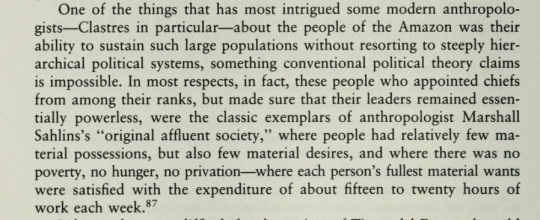
One of the things that has most intrigued some modern anthropologists—Clastres in particular—about the people of the Amazon was their ability to sustain such large populations without resorting to steeply hierarchical political systems, something conventional political theory claims is impossible. In most respects, in fact, these people who appointed chiefs from among their ranks, but made sure that their leaders remained essentially powerless, were the classic exemplars of anthropologist Marshall Sahlins’s “original affluent society,” where people had relatively few material possessions, but also few material desires, and where there was no poverty, no hunger, no privation—where each person’s fullest material wants were satisfied with the expenditure of about fifteen to twenty hours of work each week.
American Holocaust — David E. Stannard
6 notes
·
View notes
Photo
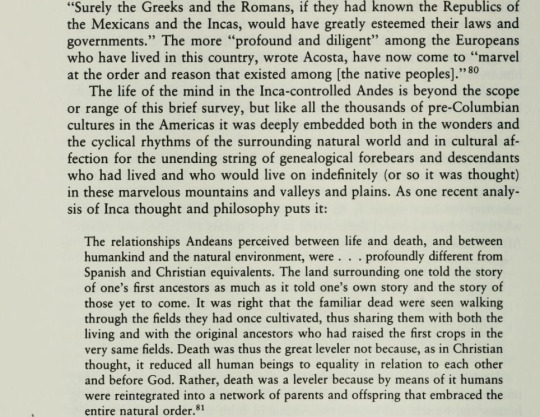
“Surely the Greeks and the Romans, if they had known the Republics of the Mexicans and the Incas, would have greatly esteemed their laws and governments.” The more “profound and diligent” among the Europeans who have lived in this country, wrote Acosta, have now come to “marvel at the order and reason that existed among [the native peoples].”
The life of the mind in the Inca-controlled Andes is beyond the scope or range of this brief survey, but like all the thousands of pre-Columbian cultures in the Americas it was deeply embedded both in the wonders and the cyclical rhythms of the surrounding natural world and in cultural affection for the unending string of genealogical forebears and descendants who had lived and who would live on indefinitely (or so it was thought) in these marvelous mountains and valleys and plains. As one recent analysis of Inca thought and philosophy puts it:
The relationships Andeans perceived between life and death, and between humankind and the natural environment, were … profoundly different from Spanish and Christian equivalents. The land surrounding one told the story of one’s first ancestors as much as it told one’s own story and the story of those yet to come. It was right that the familiar dead were seen walking through the fields they had once cultivated, thus sharing them with both the living and with the original ancestors who had raised the first crops in the very same fields. Death was thus the great leveler not because, as in Christian thought, it reduced all human beings to equality in relation to each other and before God. Rather, death was a leveler because by means of it humans were reintegrated into a network of parents and offspring that embraced the entire natural order.
American Holocaust — David E. Stannard
#inca#andes#pre-columbian#andeans#if you haven't read this it's absolutely worth the read#american holocaust#American Holocaust: The Conquest of the New World#holocaust#David E. Stannard#history#nonfiction#spanish#north america#south america#indigenous#atypicalreads#nsnv#colonialism#mesoamerica#central america#literature#the americas#scans#native american#cw violence#cw death
4 notes
·
View notes
Photo
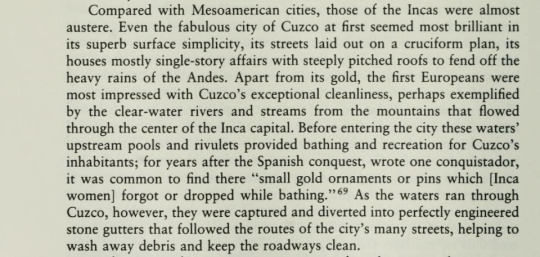
Compared with Mesoamerican cities, those of the Incas were almost austere. Even the fabulous city of Cuzco at first seemed most brilliant in its superb surface simplicity, its streets laid out on a cruciform plan, its houses mostly single-story affairs with steeply pitched roofs to fend off the heavy rains of the Andes. Apart from its gold, the first Europeans were most impressed with Cuzco’s exceptional cleanliness, perhaps exemplified by the clear-water rivers and streams from the mountains that flowed through the center of the Inca capital. Before entering the city these waters’ upstream pools and rivulets provided bathing and recreation for Cuzco’s inhabitants; for years after the Spanish conquest, wrote one conquistador, it was common to find there “small gold ornaments or pins which [Inca women] forgot or dropped while bathing.” As the waters ran through Cuzco, however, they were captured and diverted into perfectly engineered stone gutters that followed the routes of the city’s many streets, helping to wash away debris and keep the roadways clean.
American Holocaust — David E. Stannard
4 notes
·
View notes
Photo


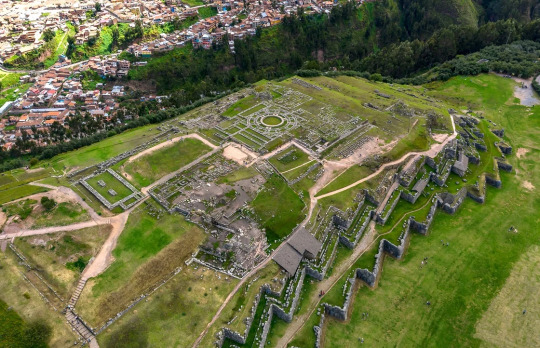







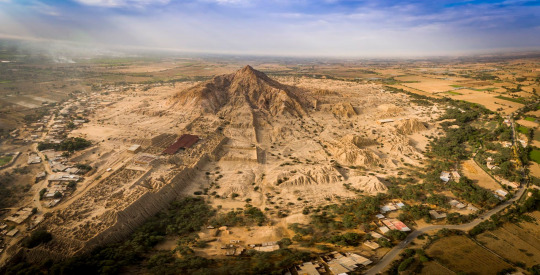



“Mesoamerica, long thought to be the precocious child of the Americas, was still confined to the Mesoamerican village during the time we are talking about, and monumental architecture in Peru was a thousand years old when the Olmecs began their enterprise. For the sake of world cultural context, this also means that Peruvian monumental architecture was in place by the time the Painted Pottery culture of neolithic northern China emerged, that it existed before England’s Stonehenge was created, and that it was already about a thousand years old when Tutankhamen’s body was being embalmed in Egypt.” - American Holocaust
59 notes
·
View notes
Text

“It’s similar to how the Sun’s magnetic field gathers, compresses, and then erupts a solar flare,” he explained. “Of course, the processes are more dramatic because the environment around a black hole is much more energetic and much more extreme. But the Sun’s surface also bubbles with activity.”
Yusef-Zadeh attributes the big, bright flares to occasional magnetic reconnection events — a process where two magnetic fields collide, releasing energy in the form of accelerated particles. Traveling at velocities near the speed of light, these particles emit bright bursts of radiation.
These findings can help us better understand the fundamental nature of these supermassive black holes embedded within galaxies, including how they get fed by their surrounding environments, and the dynamics and evolution of galaxies, in particular our own.
#sagittarius A#supermassive black hole#astrophysics#science#physics#black holes#nasa#csa#esa#smbh#milky way galaxy#milky way#jwst#james webb space telescope#james webb telescope
0 notes
Text

This artist’s concept portrays the supermassive black hole at the center of the Milky Way galaxy, known as Sagittarius A* (A-star). It’s surrounded by a swirling accretion disk of hot gas. The black hole’s gravity bends light from the far side of the disk, making it appear to wrap above and below the black hole. Several flaring hot spots that resemble solar flares, but on a more energetic scale, are seen in the disk. NASA’s James Webb Space Telescope has detected both bright flares and fainter flickers coming from Sagittarius A*. The flickers are so rapid they must originate very close to the black hole.
To conduct the study, Yusef-Zadeh and his team used Webb’s NIRCam (Near-Infrared Camera) to observe Sagittarius A* for a total of 48 hours in 8- to 10-hour increments across one year. This enabled them to track how the black hole changed over time.
Illustration: NASA, ESA, CSA, Ralf Crawford (STScI)
#JWST#james webb space telescope#james webb telescope#NASA#ESA#CSA#STScl#raif crawford#sagittarius A#black hole#milky way#milky way galaxy#nircam#near infrared camera#science#astronomy#space#supermassive black hole
1 note
·
View note
Text

Since many materials change shape when they change temperature, a test team from Ball Aerospace worked together with NASA engineers at Marshall’s X-ray and Cryogenic Facility (XRCF) to cool the mirror segments down to the temperature Webb is experiencing in deep space, -400 degrees Fahrenheit (-240 degrees Celsius).
Cryogenic testing of the primary mirror segments began in at Marshall’s XRCF by Ball Aerospace in 2009.
The change in mirror segment shape due to the exposure to these cryogenic temperatures was recorded by Ball Aerospace Engineers using a laser interferometer. This information, together with the mirrors, traveled back to California for final surface polishing at Tinsley. The mirrors’ final polish was completed in June of 2011.


By the end of 2013, all the flight primary mirror segments, as well as the secondary and tertiary mirrors would be at Goddard. The mirrors were stored in special protective canisters in the cleanroom, awaiting the arrival of the flight telescope structure.

Inside a massive clean room at NASA’s Goddard Space Flight Center in Greenbelt, Maryland the James Webb Space Telescope team used a robotic arm to install the last of the telescope’s 18 mirrors onto the telescope structure.


James Webb Space Telescope Mirror Seen in Full Bloom

Once the mirrors were completed, the science instruments were integrated into the telescope. While at Goddard, the telescope also underwent environmental testing – both acoustic and vibration – to ensure it would be able to withstand the rigors of launch. That successfully completed, the telescope was sent off to NASA Johnson in Houston, Texas, for tests of the optics and instruments at cryogenic temperatures. NASA Johnson’s Chamber A is the only thermal vacuum chamber NASA has that is large enough for Webb!
Once the telescope reached orbit, engineers on Earth made adjustments/corrections to the positioning of the Webb telescope’s primary mirror segments to bring them into alignment – to ensure they would produce sharp, focused images.
#science#nasa#goddard#james webb space telescope#james webb telescope#jwst#telescope#astronomy#physics#nasa johnson#johnson space center#houston texas#mirror polishing#Ball Aerospace#Marshall’s X-ray and Cryogenic Facility (XRCF)#xrcf#cryogenic#cryogenic testing#engineering#laser interferometer#goddard space flight center#jwst full bloom#science instruments#science achievement#human achievement
5 notes
·
View notes